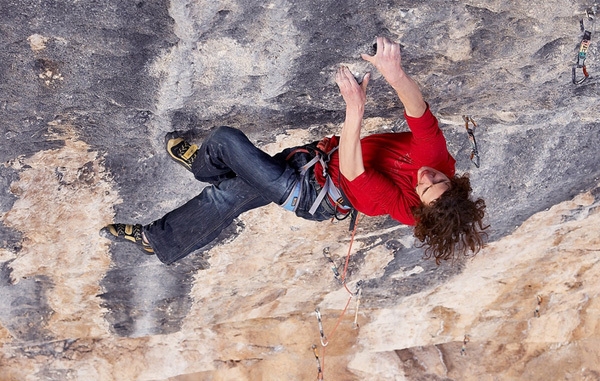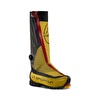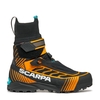Adam Ondra interview
Interview with Adam Ondra from the Czech Republic after his his January and February climbs which resulted in two 8c and one 8b+ on-sights on the same day in Claret, France, as well as a host of first ascents at Madonna della Rota, Italy

 1 / 8
1 / 8
Adam Ondra climbing Papichulo 9a+, Oliana, Spain
 Vojtech Vrzba
Vojtech Vrzba
At the end of January Czech climber Adam Ondra had another one of those startling days on rock, on-sighting two 8c's, Super Samson and Guerre d'usure and an 8b+, Elzevir in a single day in France's Claret. Another startling day, because he's no newcomer to double whammies: last year he performed a similar feat at the Covolo, returning home with Nagay and Una Vida Nomada, both 8c, which happened also to be the first ever 8c on-sights on Italian territory.
Young Ondra obviously has a penchant for the Italian peninsula, as a few weeks earlier he had kicked the new year off in style by making the first ascent of Urku 8c+ and A Present For The Future 9a/9a+ at Madonna Della Rota before moving on to Cornalba where, in truly freezing conditions, he carried out the first-ever on-sight of the classic Peter Pan 8a+ and Jedi 8b. Although the gap between 8c and 8b is understandably enormous, the fact that in over 20 years these calibre routes have never been on-sighted is significant. We checked in to find out more
Adam, let's start with Cornalba and the first on-sights of Peter Pan and Jedi - how do you rate these?
I rate them very high, especially Peter Pan. Because it's a style of climbing that is really hard to on-sight, the moves are tricky and holds invisible.
After your first visit you described Cornalba as being a crag of the future... Why?
The sector that resembles a spoon just above the village looks completely spectacular. It is surely one of the most impressive-looking walls I have seen. Although when I looked at it from the upper ledge last time I discovered that the rock isn't excellent quality, there is certainly space for some interesting new routes. On the left, two projects have already been bolted by Bruno Tassi, nicknamed "Camos". I'll be back, for sure...
I read an interview the other day on czechclimbing and you stated something interesting: you said that Ravage 8b+/8c was the first on-sight of a route put up before 1990. Can you explain this thought...
There are quite many 8b+ or 8c's in the world that was put up before 1990, probably not more than 25, but it is still quite a big number. None of these has been on-sighted except Ravage. That is quite weird, especially if you bear in mind how many people are able to on-sight 8b+ now. I am not sure if somebody else on-sighted even 8b that was put before 1990.
How can you explain this?
You could argue that this is evidence that the grades were much stiffer those days. Having said that, you have to add that these routes are usually bouldery and tricky and therefore hard to on-sight. But some climbers have manage to on-sight bouldery 8b+ from recent times, so I think there is a case that the grades are softer than they used to be.
A few years ago you surprised us, and many others, when you told us you sometimes wait up to 3 hours between attempts. Is this still the case?
I have reduced the time to two hours, but if I still feel I need really long rest, I prefer to take a 4 hours rest and warm up on a 7c 30 minutes before climbing. That's how I climbed Marina Superstar.
Well it obviously works for you! You've also made fast repeats of hard boulder problems. How do you tactics change there?
When I am bouldering I don't take rests longer that 20, maybe 30 minutes. To rest more is not effective because otherwise your muscles become stiff. Sport climbing is a bit different, because you usually have to carry out a series of moves to reach the crux, so when you get to the crux, your muscles are warm.
So after having on-sighted 8c or redpointed 9a, how do you feel the next day?
I usually feel good after climbing day, the most tired I feel is when I wake up the next morning. After midday I start to feel better again, so it is problem to avoid climbing when it's supposed to be rest day!
You won the Climbing World Cup in your debut year, but before the Rock Master you told us that you felt you didn't have much stamina. You might say that this was proved true, but how can someone with little stamina climb so hard?
After the Duel I discovered that maybe I do not have bad stamina after all: in the Duel competition everybody was complaining about pumped forearms but I was pumped only a little. But I don't have the ability to rest on bad holds, so the key for me now is to train for pure power and then I might be able to rest everywhere, just like Ramon or Patxi.
Which is why you climb so fast. And take risks...
Without any risk at all I'd have to climb way better than the others to win. I try to climb fast but at the same time I try not to take risks which are too big. How big a risk I take depends on my self-confidence. The most important thing though is to decide fast and not get stuck in some tricky section.
Sport climbing was recently recognised by the International Olympic Committee. Could this be one of your dreams?
I think climbing deserves to be Olympic sport and I would of course be delighted to compete there! I'm only seventeen... I'll keep my fingers crossed!
Cedric Lachat vs Adam Ondra, Duel - Rock Master 2009
The Duel was won by a superlative Cedric Lachat who beat Adam Ondra by an imaginary margin: 8 milliseconds! After climbing a 18 meter 7c+, the two were separated by a mere eight milliseconds. Unbelievable!
Young Ondra obviously has a penchant for the Italian peninsula, as a few weeks earlier he had kicked the new year off in style by making the first ascent of Urku 8c+ and A Present For The Future 9a/9a+ at Madonna Della Rota before moving on to Cornalba where, in truly freezing conditions, he carried out the first-ever on-sight of the classic Peter Pan 8a+ and Jedi 8b. Although the gap between 8c and 8b is understandably enormous, the fact that in over 20 years these calibre routes have never been on-sighted is significant. We checked in to find out more
Adam, let's start with Cornalba and the first on-sights of Peter Pan and Jedi - how do you rate these?
I rate them very high, especially Peter Pan. Because it's a style of climbing that is really hard to on-sight, the moves are tricky and holds invisible.
After your first visit you described Cornalba as being a crag of the future... Why?
The sector that resembles a spoon just above the village looks completely spectacular. It is surely one of the most impressive-looking walls I have seen. Although when I looked at it from the upper ledge last time I discovered that the rock isn't excellent quality, there is certainly space for some interesting new routes. On the left, two projects have already been bolted by Bruno Tassi, nicknamed "Camos". I'll be back, for sure...
I read an interview the other day on czechclimbing and you stated something interesting: you said that Ravage 8b+/8c was the first on-sight of a route put up before 1990. Can you explain this thought...
There are quite many 8b+ or 8c's in the world that was put up before 1990, probably not more than 25, but it is still quite a big number. None of these has been on-sighted except Ravage. That is quite weird, especially if you bear in mind how many people are able to on-sight 8b+ now. I am not sure if somebody else on-sighted even 8b that was put before 1990.
How can you explain this?
You could argue that this is evidence that the grades were much stiffer those days. Having said that, you have to add that these routes are usually bouldery and tricky and therefore hard to on-sight. But some climbers have manage to on-sight bouldery 8b+ from recent times, so I think there is a case that the grades are softer than they used to be.
A few years ago you surprised us, and many others, when you told us you sometimes wait up to 3 hours between attempts. Is this still the case?
I have reduced the time to two hours, but if I still feel I need really long rest, I prefer to take a 4 hours rest and warm up on a 7c 30 minutes before climbing. That's how I climbed Marina Superstar.
Well it obviously works for you! You've also made fast repeats of hard boulder problems. How do you tactics change there?
When I am bouldering I don't take rests longer that 20, maybe 30 minutes. To rest more is not effective because otherwise your muscles become stiff. Sport climbing is a bit different, because you usually have to carry out a series of moves to reach the crux, so when you get to the crux, your muscles are warm.
So after having on-sighted 8c or redpointed 9a, how do you feel the next day?
I usually feel good after climbing day, the most tired I feel is when I wake up the next morning. After midday I start to feel better again, so it is problem to avoid climbing when it's supposed to be rest day!
You won the Climbing World Cup in your debut year, but before the Rock Master you told us that you felt you didn't have much stamina. You might say that this was proved true, but how can someone with little stamina climb so hard?
After the Duel I discovered that maybe I do not have bad stamina after all: in the Duel competition everybody was complaining about pumped forearms but I was pumped only a little. But I don't have the ability to rest on bad holds, so the key for me now is to train for pure power and then I might be able to rest everywhere, just like Ramon or Patxi.
Which is why you climb so fast. And take risks...
Without any risk at all I'd have to climb way better than the others to win. I try to climb fast but at the same time I try not to take risks which are too big. How big a risk I take depends on my self-confidence. The most important thing though is to decide fast and not get stuck in some tricky section.
Sport climbing was recently recognised by the International Olympic Committee. Could this be one of your dreams?
I think climbing deserves to be Olympic sport and I would of course be delighted to compete there! I'm only seventeen... I'll keep my fingers crossed!
Cedric Lachat vs Adam Ondra, Duel - Rock Master 2009
The Duel was won by a superlative Cedric Lachat who beat Adam Ondra by an imaginary margin: 8 milliseconds! After climbing a 18 meter 7c+, the two were separated by a mere eight milliseconds. Unbelievable!
Note: Adam Ondra - 05/02/1993 Brno, Czech Republic
08/2002: Funky shit 8a Paklenica. First 8a redpoint
05/2003: Slimline 8a Frankenjura. First 8a on-sight
04/2004: Mrtvaski ples 8b Misja pec, Slovenia. First 8b redpoint
12/2004: Mascherina 8c Sperlonga, Italy. First 8c redpoint
02/2005: Veper Lady 8b Osp, Slovenia. First 8b on-sight
01/2006: Alien Carnage 8c+, Castillon, France. First 8c+.
09/2006: F.A. Vymena Manzelek, 8c at Moravsky Kras, Czech Republic.
11/2006 Martin Krpan 9a, Mmisja Pec, Slovenia. First 9a redpoint.
08/2007: Silbergeier 8b+, 200m, Rätikon, Switzerland. First one-day ascent of 1994 Beat Kammerlander route.
02/2008: La Rambla 9a+, Siurana, Spain. Fifth attempt.
02/2008: Digital System 8c Santa Linya, Spain. First 8c on-sight
05/2008: Action Direct 9a, Frankenjura. 10th ascent of 1991 benchmark Wolfgang Güllich route
09/2008: winner Arco Rock Legends
10/2008: Hotel Supramonte 8b+, 400m Sardinia. First on-sight.
11/2008: Open Air 9a+, Schleierwasserfall. First repeat of 1992 Alexander Huber route.
05/2009: Two 8c on-sights in a single day, Covolo, Italy
09/2009: Ravage 8b+/8c, Basler Jura, Switzerland. First on-sight of 1986 Antoine Le Menestrel route.
10/2009: F.A: Marina Superstar 9a+/9b , Grotta San Giovanni, Sardinia
11/2009: wins Climbing World Cup Lead 2009 in his debut year
01/2010: F.A. A Present For The Future 9a/9a+, Madonna Della Rota, Italy
01/2010: Two 8c and one 8b+ on-sights in a single day, Claret, France
08/2002: Funky shit 8a Paklenica. First 8a redpoint
05/2003: Slimline 8a Frankenjura. First 8a on-sight
04/2004: Mrtvaski ples 8b Misja pec, Slovenia. First 8b redpoint
12/2004: Mascherina 8c Sperlonga, Italy. First 8c redpoint
02/2005: Veper Lady 8b Osp, Slovenia. First 8b on-sight
01/2006: Alien Carnage 8c+, Castillon, France. First 8c+.
09/2006: F.A. Vymena Manzelek, 8c at Moravsky Kras, Czech Republic.
11/2006 Martin Krpan 9a, Mmisja Pec, Slovenia. First 9a redpoint.
08/2007: Silbergeier 8b+, 200m, Rätikon, Switzerland. First one-day ascent of 1994 Beat Kammerlander route.
02/2008: La Rambla 9a+, Siurana, Spain. Fifth attempt.
02/2008: Digital System 8c Santa Linya, Spain. First 8c on-sight
05/2008: Action Direct 9a, Frankenjura. 10th ascent of 1991 benchmark Wolfgang Güllich route
09/2008: winner Arco Rock Legends
10/2008: Hotel Supramonte 8b+, 400m Sardinia. First on-sight.
11/2008: Open Air 9a+, Schleierwasserfall. First repeat of 1992 Alexander Huber route.
05/2009: Two 8c on-sights in a single day, Covolo, Italy
09/2009: Ravage 8b+/8c, Basler Jura, Switzerland. First on-sight of 1986 Antoine Le Menestrel route.
10/2009: F.A: Marina Superstar 9a+/9b , Grotta San Giovanni, Sardinia
11/2009: wins Climbing World Cup Lead 2009 in his debut year
01/2010: F.A. A Present For The Future 9a/9a+, Madonna Della Rota, Italy
01/2010: Two 8c and one 8b+ on-sights in a single day, Claret, France
| Links Planetmountain | |
| News Adam Ondra | |
| Links Expo.Planetmountain | |
| Expo La Sportiva | |
| Expo Black Diamond | |
| Links www | |
| www.czechclimbing.com | |
| www.climb4fun.cz | |
Latest news
Expo / News
Expo / Products
Petzl Irvis Hybrid crampons for ski touring and approaches involving glacier travel.
The world’s lightest – and most technically advanced – high altitude mountaineering boots.
Ever since its market launch, the Barryvox avalanche transceiver has been among the most reliable transceivers in the world.
Ferrino OSA 32, a backpack for freeriders and ski mountaineers providing maximum ergonomics and functionality.
Revolutionary fast & light mountaineering boot SCARPA RIBELLE TECH 3 HD, with superior waterproof and breathable protection thanks to HDry technology.
Merino Wool Socks for Ice Climbing and Dry Tooling.



 Copia link
Copia link






 See all photos
See all photos






















